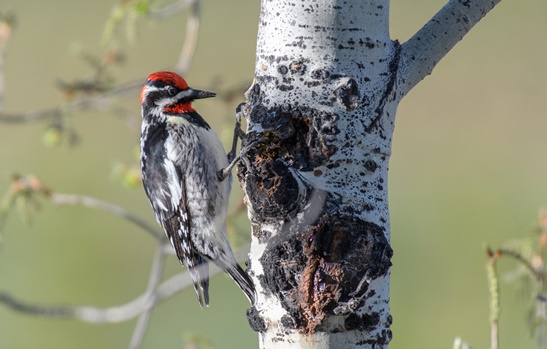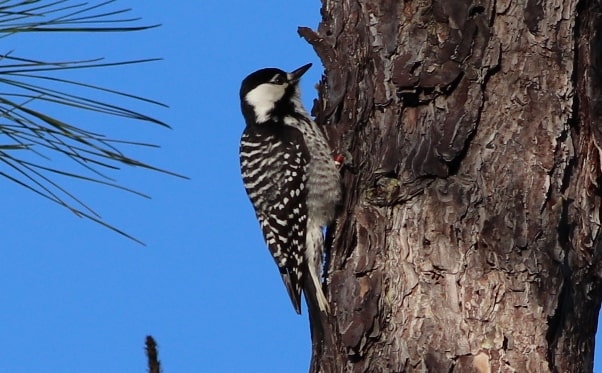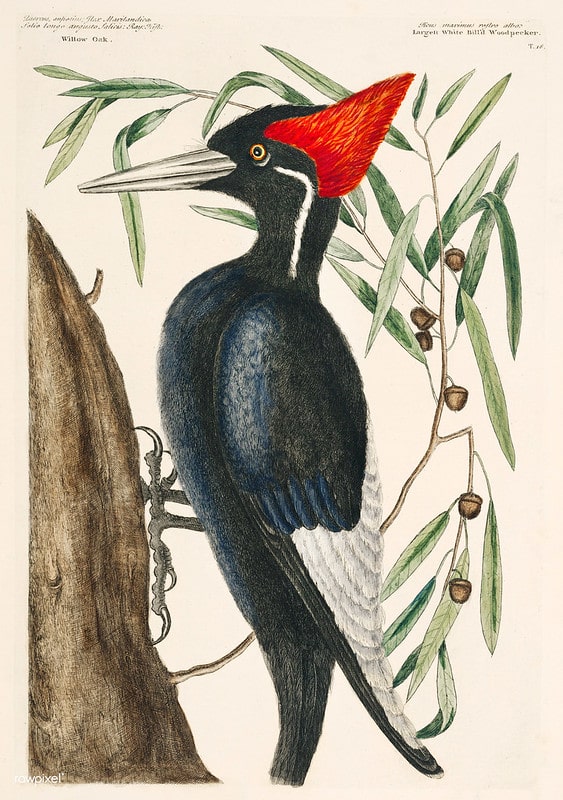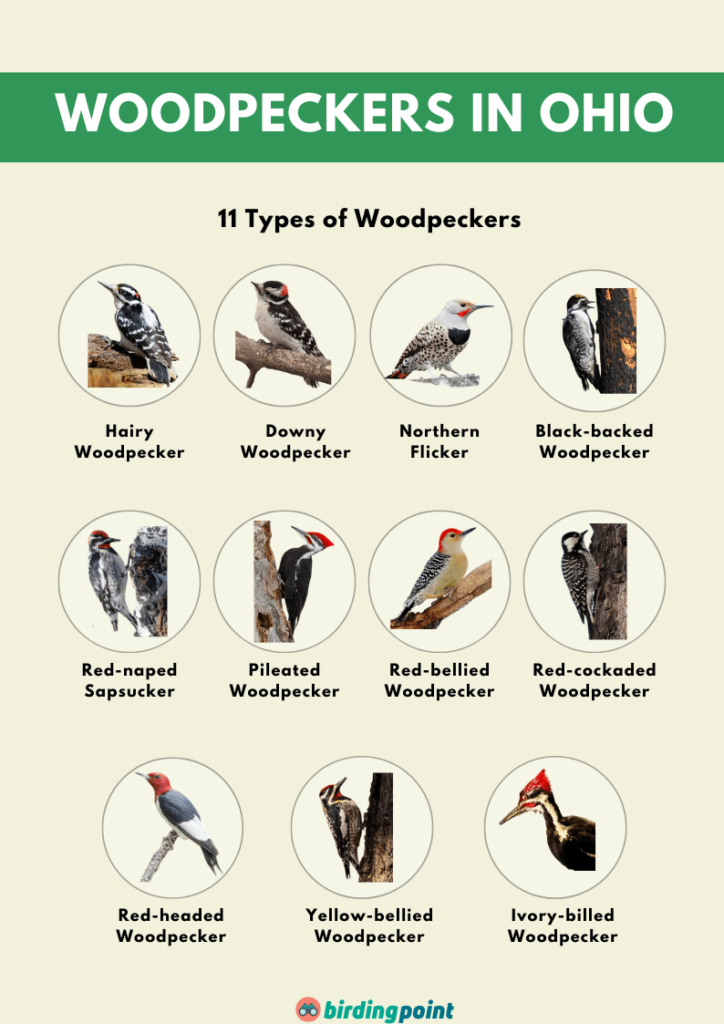The buckeye state is known for its range of cities, wilderness areas, and state parks, all of which make for perfect places to watch for woodpeckers year-round.
Whether you’re searching in a wetland area, near one of the state’s beautiful lakes, or right in your own backyard, there are many woodpecker species ranging from large to small that you can find.
Some woodpeckers in Ohio, such as the downy, make the state their home all year long, so you can spot them even during the cold winter months. Other types of woodpeckers in Ohio are rare and require a watchful eye to identify.
To find woodpeckers, look for areas with dead trees, pines, or suburban yards with suet feeders.
Here is the list of woodpeckers in Ohio:
- Downy Woodpecker
- Black-backed Woodpecker
- Hairy Woodpecker
- Red-naped Sapsucker
- Pileated Woodpecker
- Red-bellied Woodpecker
- Northern Flicker
- Red-cockaded Woodpecker
- Red-headed Woodpecker
- Ivory-billed Woodpecker
- Yellow-bellied Sapsucker
11 Types of Woodpeckers in Ohio
1. Downy Woodpecker

Scientific name: Dryobates pubescens
Size: 7 inches long
Weight: 0.75-0.99 ounces
Wingspan: 10-12 inches
The smallest woodpecker species in the US, the downy woodpecker doesn’t migrate during the year; but instead, it makes Ohio its home year-round.
You can find this itty-bitty woodpecker in rural areas, cities, suburban yards, and wilderness areas. During the wintertime, they flock with other common birds such as chickadees and nuthatches, and they build their nests in the cavity of trees. While they may change their habitat range during the seasons, they don’t migrate far as many birds do.
Downy woodpeckers are black and white, with distinctly spotted wings and a white chest. Adult males have a bright red cap on the back of their heads, which makes them easy to identify from females.
If you want to observe the behavior of these birds, put a suet feeder in your yard. They love them and won’t hesitate to hang out for a bit so that you can watch them.
Because of their small size, they can access parts of the tree or land on small stems of plants to hunt for food. They’re also small enough that they often make nests in the wood siding of homes, much to the dismay of homeowners.
2. Black-backed Woodpecker

Scientific name: Picoides arcticus
Size: 9.1 inches
Weight: 2.1-3.1 ounces
Wingspan: 15.8-16.5 inches
Many woodpeckers in North America have some pattern of black and white, often with a red patch on the head or cheeks. This woodpecker stands out because of its solid black back and white chest. It has a black face with a distinct white stripe. The male has a small yellow crown.
Making its home in burned-out forests across all of Canada and the western US, with a few colonies in areas like northern Michigan, New York, Ohio, New Hampshire, and Maine.
Its black coloring helps it blend in with the charred trees that it hunts on. It eats beetle larvae and seeks out recently-burned areas, where it lives for several years before moving onto more newly burned areas.
3. Hairy Woodpecker

Scientific name: Picoides villosus
Size: 7.5 inches
Weight: 1.4-3.4 ounces
Wingspan: 13-16 inches
Hairy woodpeckers are sometimes confused with downy woodpeckers, but you can tell them apart because hairy woodpeckers are larger. They also have a longer bill, almost the length of their head, which further sets them apart from downy woodpeckers. They are black and white all over their bodies. You can tell the genders apart because the adult males have a little red spot on the back of their heads.
These striking woodpeckers aren’t as common in cities as their cousin, the downy woodpecker, but you can still see them in parks, suburban areas, cemeteries, and other quiet wooded or open areas. They also visit suet feeders in suburban backyards.
Hairy woodpeckers don’t migrate during the seasons. Instead, they stay in the same region all year. They make their nests in the cavities of dead trees. Research published in The Journal of Wildlife Management found that they prefer forests that have been burned recently.
Populations have been declining in the past few decades because they’re losing their habitat. They also face pressure from invasive birds like European starlings, which take over their nests.
4. Red-naped Sapsucker

Scientific name: Sphyrapicus nuchalis
Size: 7.5-8.3 inches
Weight: 1.1-2.3 ounces
Wingspan: 16-16.9 inches
As the name suggests, this bird eats the sap in trees. It will tap tiny holes into the bark so that sugary sap runs out and it can dine on it. They particularly love aspen, pine, and birch trees. They’ll even nest in backyards that have those trees, and they will stop and visit if you provide them with a suet feeder.
These sapsuckers have vertical white patches that you can only see when the wing is folded. They have black and white striped bodies and heads and a bright red cap and throat, though some females have a white throat.
This is a close relative of the red-bellied sapsucker and the yellow-bellied sapsucker. They all look pretty similar, with slightly different coloring.
5. Pileated Woodpecker

Scientific name: Dryocopus pileatus
Size: 16-19 inches
Weight: 9-14 ounces
Wingspan: 30 inches
The pileated woodpecker is the largest woodpecker in Ohio. They live everywhere in Ohio except the northwestern part of the state.
They often make their nests in utility poles or high up in tall trees that have died. They love to snack on carpenter ants, and they will dig rectangular holes deep into the wood to find them.
They’ll also eat nuts and berries and have even been known to munch on poison ivy berries. You may occasionally see them foraging on the ground for food, but they usually stick to the trees.
These striking birds are primarily black and white, but they are distinct because of their bright red crest. The males also have a red stripe on the side of their faces. These are larger birds, about the same size as a crow.
The pileated woodpecker doesn’t migrate and stays in the same area year after year. They will, however, move their nest nearby if the eggs fall out of it.
The cartoon bird Woody Woodpecker was likely based on this species.
6. Red-bellied Woodpecker

Scientific name: Melanerpes carolinus
Size: 9.5 inches
Weight: 2.0-3.2 ounces
Wingspan: 13.0-16.5 inches
You’d probably expect these woodpeckers to have visibly bright red bellies, but that’s not the case. Typically, their bellies are a pale creamy white. Their back and wing feathers are black and white striped, and the females have a red nape. The males have a red nape and crown.
So, where did the name come from? The woodpeckers do have red feathers on their bellies, but white feathers usually cover them, so you can’t see them.
These active birds live all across the Eastern United States, and you can spot them in the air as they fly by their undulating flight pattern.
Otherwise, look for them in oak and hickory trees, where they like to feed and nest. They’ll also pop up at suet feeders now and then.
7. Northern Flicker

Scientific name: Colaptes auratus
Size: 11-12 inches
Weight: 4-6.5 ounces
Wingspan: 16.5-20 inches
The beautiful northern flicker is one of the common types of woodpeckers in Ohio. It lives in open habitats near trees, as well as in parks and cemeteries. They are a frequent visitor to suet feeders in suburban and urban yards. Unlike some woodpeckers in Ohio, you may see them hunting around on the ground rather than in the trees.
The males, females, and juveniles all differ in appearance, and they can look different depending on the region they live in. They are brown in color overall, with black spots. The underside of the wings and tails are yellow in the eastern half of the US and red in the western half of the US.
Some of these woodpeckers have a red or black stripe on their cheeks, and many of them have large, black crescents on their chest. Others have red marks on the back of the head. Some have a slightly gray head.
In the spring, you can hear the calls of Northern flickers for a long way. It’s a familiar sound, and once you know how to identify their calls and drumming, it’s easy to tell when they’re around.
They primarily eat ants, but they’ll eat insects such as caterpillars, beetles, and termites if they find them. There are also reports that they can catch young bats as they leave the nest. You can entice them to visit your home by offering a suet feeder in the yard.
Northern flickers that live in Alaska and Canada will migrate to areas that have higher temperatures in the south during the winter.
Studies show that Northern Flickers can lose their nests to invaders like European starlings, putting pressure on their populations.
8. Red-cockaded Woodpecker

Scientific name: Dryobates borealis
Size: 7.9-9.1 inches
Weight: 1.5-1.8 ounces
Wingspan: 14.2 inches
This non-migratory species lives year-round in its habitat, which includes the southern states of the US from Virginia down the coast to Florida and as far west as the eastern edge of Texas. In other parts of the midwest, such as Ohio, you might rarely see them visiting, but they don’t live there.
You might expect this bird to have a dramatic red mark, given its name. In actuality, only the males have any red at all, and it’s a tiny little stripe on its cheek. Don’t try to identify this bird by the little streak, however. It’s pretty much impossible to see unless you’re right up close.
The rest of the bird is black and white with barred stripes on the wings and a mottled pattern on the chest. The head is white with a black crown and a stripe down the cheek that extends down the neck. The males and females look similar and can be hard to tell apart.
This bird has been losing its habitat due to logging and suburban spread and is on the conservation red watch list, and has been endangered since 1970. It lives in old-growth, long-leaf pine forests, so it’s unlikely that you’ll see this in your backyard.
If you go out hunting to spot this bird, be aware that many of its habitats are protected and closed to public access. Bird watchers may, however, be able to obtain permission to search for them.
9. Red-headed Woodpecker

Scientific name: Melanerpes erythrocephalus
Size: 7.5-9.1 inches
Weight: 2.0-3.2 ounces
Wingspan: 16.5 inches
Red-headed woodpeckers are striking birds. They have solid black wings with a big white patch on them and white bodies. To top it off, they have a deep, dark red head and neck that is so vibrant it looks like velvet.
The juveniles are brownish-black with white spots on the wings and dull red cheeks.
They don’t cross the Rocky Mountains, but they can be found in all parts east, from Canada to Florida. They winter in Texas, southern Ohio, and northern Mexico, and breed in the northern end of the US and southern Canada.
It’s one of the few woodpeckers out there who like to store food for the winter. They stuff seeds and nuts in bark or holes in trees. They have even been known to stuff food under shingles.
They also hunt their prey, snatching insects out of the air, another rare behavior for woodpeckers.
10. Ivory-billed Woodpecker

Scientific name: Campephilus principalis
Size: 18.1-20.1 inches
Weight: 15.9-20.1 ounces
Wingspan: 29.9-31.5 inches
The ivory-billed woodpecker is enormous. It’s the largest North American species. This woodpecker’s habitat spans across the southern US from Florida to Texas in areas where flooding and fires have made it easier for them to find their favorite food: beetle larvae.
Unfortunately, deforestation caused their populations to drop dramatically during the 19th century. As of the mid-1900s, there were only a few left. But in 2004, they were spotted in Arkansas, renewing hope that they might still be around.
Keep an eye out for this bird when you go bird hunting in Ohio. It has a long, straight, ivory-colored bill and is black and white. The males have a red crest, while the females have a black one. They both have white streaks that extend down the back.
If you do happen to spot this bird, be sure to let your local government know. Tim Gallagher, who spotted the bird in 2004, argues in an article for Audubon that while some government experts want to declare the bird extinct, there is compelling evidence that they still exist in the swamps and bayous of the south.
11. Yellow-bellied Sapsucker

Scientific name: Sphyrapicus varius
Size: 7.1-8.7 inches
Weight: 1.5-1.9 ounces
Wingspan: 13.4-15.8 inches
The beautiful yellow-bellied sapsucker migrates across Ohio, but it doesn’t live there year-round. You’ll only be able to spot it during the migratory season.
These birds are primarily black and white, with white bellies, and black and white barred wings and back. You can tell the difference between males and females because the male’s throat is bright red. Females, on the other hand, have a white throat. Both the females and males have red foreheads.
The females have a faint yellow coloring to their bellies, but it might be so light that you might not be able to identify it, so don’t rely on that coloring to help you confirm your sighting.
The birds drill tiny holes with their beaks, and then they wait for the sweet sap to emerge from the tree. They lick this up, as well as any insects that crawl along and get themselves stuck in the sap.
You might see them hanging out at your backyard suet feeder, but they mostly stick to forested areas.

Other Species of Birds in Ohio: Owls in Ohio Hummingbirds in Ohio
